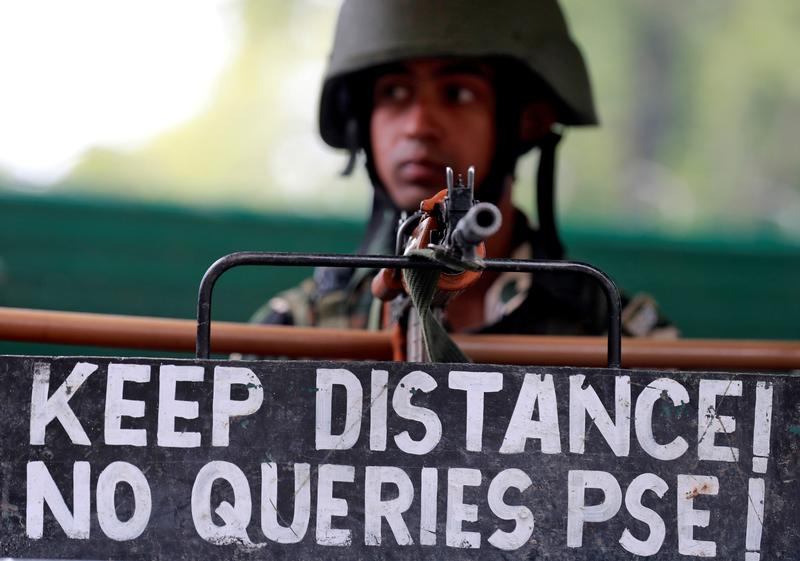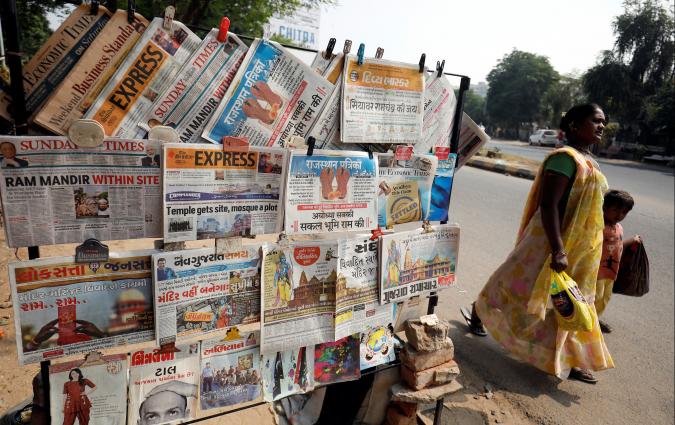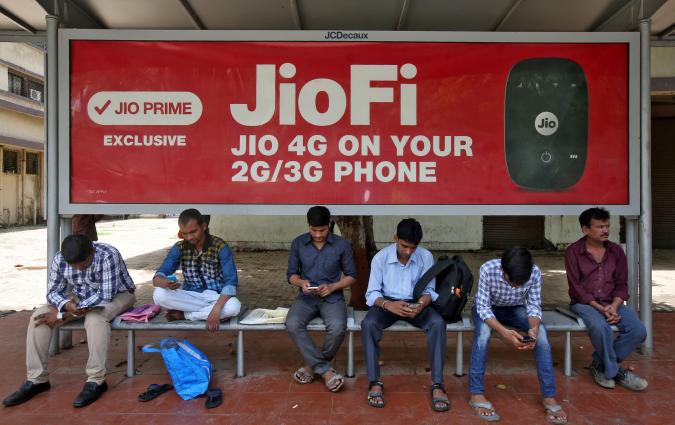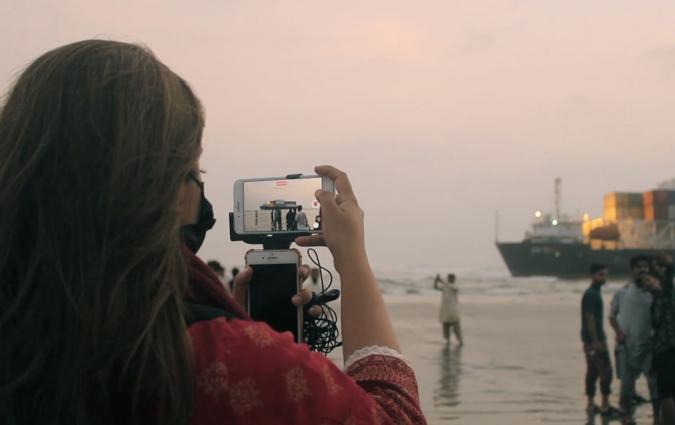In this piece
Killing the story: How the Kashmiri press was silenced after the region lost autonomy

An Indian security force personnel keeps guard alongside a road during restrictions after the government scrapped the special constitutional status for Kashmir, in Srinagar August 15, 2019. REUTERS/Danish Ismail
In this piece
How the crackdownstarted | Two distinct public spheres | Adeafeningsilence | How the local press sufferedJournalist Irfan Amin Malik was having a quiet evening at home with his family. It was August 14, 2019, the eve of Indian Independence Day celebrations. Security was tight, especially in South Kashmir, where Malik lives. All the phones were dead. There was no internet.
“I was showing my wife some pictures on my phone,” he remembered. “Then my sister – she was downstairs – called us to say someone was knocking on our door. My parents went out and found security forces in our compound. They had not just opened the door; they climbed over the walls. I saw 50 to 60 security personnel. It was like they had come to capture a big terrorist.”
They had come to arrest Malik, who covered South Kashmir for a well-known local daily, Greater Kashmir. An officer asked him to accompany them to the police station, about half a kilometre away. No reason was offered, Malik said.
It was not until the following evening, on Independence Day, that Malik was released from custody. Before he was allowed to go, he had to sign a bond. “It mentioned that my detention was necessary for peace in a particular area. If I was out there, I would be a threat to peace,” said Malik.
How the crackdown started
The events leading up to Malik’s arrest went back nine days to August 5, 2019, when the Indian government stripped the state of Jammu and Kashmir of autonomy and split it into two Union Territories, directly controlled by the central government.
Or maybe the events went back 70 years, to when India and Pakistan became two separate states in 1947. Both states claim the entire territory of Jammu and Kashmir – a crown-shaped piece of land once ruled by the Dogra kings. The two countries have fought three wars over it, leaving the region divided by a makeshift ceasefire line that has come to be known as the Line of Control (LoC). Since 1989, the Kashmir Valley on the Indian side of the LoC has also had an armed movement for secession from the Indian state. While some factions of the militancy favoured merging with Pakistan, others wanted an independent Jammu and Kashmir.
On August 5, 2019, the Indian Parliament attempted to snuff out that debate by revoking the autonomy guaranteed to Jammu and Kashmir under Article 370 of the Indian Constitution. It also repealed Article 35A, which ensured special protections to people defined as permanent residents of Jammu and Kashmir. The two new Union Territories were Ladakh, an expanse of mountainous desert that is partly claimed by China, and Jammu and Kashmir, two regions hyphenated by geopolitics but coexisting in an uneasy truce.
This essay is focused on the Kashmir Valley. When India’s central government, popularly referred to as “the Centre”, revoked autonomy on August 5, 2019, it cited militancy in Kashmir as one of its reasons. The unruly Valley, which demanded “azadi” (freedom) from the Indian state, had to be co-opted into the project of “national integration”.
For this project to succeed, it was important the legislative changes received favourable press coverage. From the largely state-centric national media, the government had little to fear. The local press was another story.
One of the many outcomes of the conflict was the extraordinary growth of the Kashmiri press. Over the past three decades, it had become the cornerstone of a Kashmiri public sphere dominated by the demand for freedom. Since 1989, Kashmir’s burgeoning press had negotiated the external pressures from both militant groups and the state, who were engaged in an information war.
By 2019, the government had developed more sophisticated tools of control, while militant groups were decimated. So when the Centre moved in on August 5, it was able to shut down a vibrant, adversarial local press almost overnight.
The state was able to gain influence over the Kashmiri press by controlling the levers of production: government advertisements were withheld or released according to the content that was published. Besides, journalists and editors critical of the government and security forces faced legal action, harassment and violence. Government policies explicitly controlling the press were also formulated.
As the government revoked autonomy and special status for Jammu and Kashmir in August 2019, thousands of troops were deployed in the region. All communication lines were snapped and the region was placed under complete lockdown to quell dissent against the legislative changes.
While the press was being silenced, almost all of the political leadership in Kashmir was rounded up and arrested or detained. Activists, lawyers and any individuals identified as a threat to peace were also swept into preventive detention. The crackdown on the Kashmiri press was necessary to manage perceptions around the August 5 legislation. I also argue it was part of a more ambitious project to remake the Kashmiri public sphere: from its politics to its information economy.
Two distinct public spheres
Jürgen Habermas’s “public sphere”, according to Professor Simon Cottle, is “a communicative space in which ideas and information, discourses and opinions find representation and elaboration and thereby help constitute civil societies”. The Indian national media and the Kashmiri press reflected two entirely different public spheres.
At the national level, much of the mainstream media embodies the majoritarian politics that has come to dominate India’s public life. So its celebration of “national integration” shaped a consensus on the August 5 decisions in the Indian mainland.
Left to itself, the Kashmiri press was unlikely to have followed that narrative. For decades, Article 370 had marked out Jammu and Kashmir as politically and geographically distinct. The Valley, with its predominantly Kashmiri Muslim population, and its history of struggle against Dogra rule, was also politically distinct from Jammu. The Kashmiri press, which had grown during three decades of conflict, was traditionally adversarial to the state.
The newspapers launched in the first decade of the conflict fed a hunger for local news. There was no telling which town was curfewed, which village was under an Army crackdown, where the latest gunfight had broken out, whose son had disappeared the night before. “When there is a threat to your life, the only thing that keeps you alive is to stay updated,” said a researcher who grew up in downtown Srinagar, an epicentre for the militancy in the early days.
Growing literacy swelled readership, but there were other important factors driving this demand for news, according to a media researcher based in Kashmir.* Residents of the Valley did not buy the “national media narrative”, he said. It was the local press that reflected their lived realities and covered the minutiae of regional political developments. These newspapers spoke the language of the Kashmiri public sphere, a language of dissent.
National coverage of the politics of Kashmiri separatism was replete with guns and fanatics, described as stemming partly from religious fundamentalism, and partly thanks to the machinations of Pakistan. The local press spoke more freely of Kashmiri self-determination and covered separatist politics in tandem with pro-India parties. In the early days of the militancy, some Urdu publications even carried interviews with militant commanders.
During the second wave of the armed movement, which picked up pace up a decade ago, interviewing militants was no longer within the realm of the permissible. But local papers extensively covered militant funerals, where large crowds of mourners chanted slogans for azadi [freedom], an evidence of popular support. They also devoted their energies to reporting on human rights violations: from enforced disappearances and shootings to violent police action on protesting crowds that left hundreds dead or maimed.
Pressures from the national public sphere, with its centre of gravity in Delhi, always acted on the Valley. Decades of conflict have fed into the spectre of the “markaz”, the central government, controlling public life in the Valley. According to popular lore, sinister machinations of the markaz are behind a range of events in Kashmir: from changes in the local government to the splintering of a militant group, from rumours that set off panic to the placement of street lamps.
In this context, the press became an arena for the unequal political contest between the markaz and the Valley. Professor Gadi Wolfsfeld describes such contests as “public confrontations between a government and at least one other antagonist in which the state […] has a significantly superior amount of coercive reserve at its disposal”. Competition over the news media, he writes, is “part of a larger and more significant contest among political antagonists for political control”.
In the case of Kashmir, this was not just a contest between the national and local press, but a battle for control over the local press itself. Eventually, the state won.
Apart from physical intimidation and police cases, the most well-worn means of containing the local press was through withholding funds. “There are four key sources of revenue for any media,” said the editor of an English magazine in Srinagar. First, there were advertisements from the local private sector, which barely exists in Kashmir. Second, corporate advertisements from various parts of India, which rarely reached the Valley. Third, central government advertisements. Finally, there were advertisements from the local Department of Information, the mainstay of the Kashmiri press.
Early on, leading dailies were accused of taking funds from both sides – government and separatist. Whatever the truth of these allegations, the government soon wielded far greater financial control over the local press.
In 2017, a Union Home Ministry report suggested that the government establish greater “control” over mosques, madrasas, newspapers and television channels. Later that year, the ministry recommended that the state government stop advertisements to papers that published “anti-national articles”. By August 2019, the state of Jammu and Kashmir had been erased and the local directorate of information was part of the Union Territory administration, taking directions from the Centre.
The markaz had emerged from the shadows. It was officially in charge.
A deafening silence
As Kashmir went through cataclysmic political changes after August 5, 2019, politics dropped off the pages of its newspapers. In the international media and sections of the independent national media, there were reports on human rights violations by security forces in the districts of South Kashmir and protests in a Srinagar neighbourhood. The Kashmiri press, once dedicated to documenting the toll of conflict, barely spoke of it.
What accounted for this silence? There were physical curbs such as the communications blockade, the lockdown, the presence of troops at every street corner. But that was not the whole story.
If there was a formal government veto on critical reporting, few editors or reporters in Srinagar will speak of it. Instead, most journalists talk about a cloud of suggestion and fear emanating from the government, paralysing the local press.
The message went out in a number of ways. In the early weeks after August 5, 2019, journalists leaving their homes were travelling into oblivion. You could be arrested or beaten up and no one would know. And there had been actual arrests – Qazi Shibli, editor of The Kashmiriyat, an online only news portal, was held days before August 5 and questioned about his coverage of the security build up in the run up to the legislative decisions.
Those who still wrote critical reports were met with intimidation, even open rebuke. “Now, the SSP [senior superintendent of police] will call up the reporter directly and threaten to lodge a FIR,” said one young journalist in Srinagar. FIRs, or first information reports, are preliminary police complaints lodged before an investigation can begin.
The message also trickled down through editorial diktats in newsrooms, where reporters say they were warned not to stray from the government line. A young reporter at another English daily said she was instructed to do “soft” stories. They were encouraged to do stories on health amid the communication blackout. Stories more directly linked to the political situation were embargoed.
Many other stories died a quiet death because of stonewalling by government sources, local journalists say. They could report press releases handed out by the Department of Information. But specific questions were rarely entertained. Without an official version, many stories could not be published.
In the weeks following the August 5 decisions, the government controlled the flow of information through a “media centre” set up at a plush hotel in Srinagar, the political nerve centre of the region. Government officials would hold daily briefings here, largely for the benefit of journalists from the national media, most of whom were staying in the hotel. For weeks, the media centre was also the only source of internet for journalists in the Valley, who queued up to file their stories there every evening.
As the excitement around the decisions waned, and the national media left the Valley, local journalists were herded into the offices of the Department of Information at Srinagar. This became the new “media centre”. For months, this was the only source of high speed internet for Kashmiri journalists, many of whom had to drive for hours to file their stories. News from districts outside Srinagar inevitably dried up.

How the local press suffered
The crackdown crippled the local press in material ways, leaving it shorn of revenues. Government ads, long used to control the local press, dried up overnight. Even when they started trickling back, they would be withdrawn abruptly if newspapers published critical content, local journalists say. Revenue losses forced salary cuts and layoffs. Together with the long lockdown, they also drove a drastic fall in circulation.
The crackdown has also left its imprint on the very nature of news. While some stories dropped off the pages entirely, others were treated differently after August 5, 2019. Three subjects, in particular, reflect a marked change: gunfights between militants and security forces, civil protests, and separatist politics.
For years, the facts of these gunfights have been disputed: who opened fire, whether the militants were asked to surrender, whether civilians were killed, whose bullets killed whom. Local accounts and the state version have often diverged. After August 5, 2019, reporters started avoiding the sites of these gunfights, relying on press releases by state agencies instead. Those who did visit the sites to collect local accounts found themselves unable to get a state response to specific questions or allegations. “How do you report a gunfight without an Army or a police quote?” asked Zaid. “Do we kill the story?”
If local voices faded from stories on gunfights, local protests were also muffled. The mass protests of the past decade had been covered closely by the Kashmiri press. It recorded public furies against the government as well as the state crackdown on protesters. After August 2019, civilian injuries may still be reported but recounting the anti-government sentiments that drive protests has become taboo.
Alongside the expression of anti-government sentiment, reporting separatist politics was also proscribed. Statements made by the separatist leadership of the Hurriyat, a conglomeration of separatist parties, have all but disappeared from news pages.
Finally, government control over the press was formalised by the “New Media Policy”, announced in May 2020 by the Department of Information and Public Relations.
First, the policy seems to redefine all news flowing from the government as publicity to create “a sustained narrative on the functioning of the Government in the media”. This was necessary because the “transformative process” of revoking special status had not been covered by the media to the government’s satisfaction.
Second, it devised mechanisms to vet both news content and journalists working in the Valley. According to the government, these were needed to address “the issue of fake news” and “plagiarism”.
Third, it laid down fresh criteria for “empanelment”, or inclusion in the list of publications eligible for government advertisements. Ad revenues were also to be refocused on “new media”, namely social and online media.
The new media policy spelt out the state’s power to monitor and punish journalists for their work. It dovetailed neatly into the Centre’s project of fashioning a “Naya Kashmir”, or New Kashmir. It is to be a polity that breaks with the past.
How Kashmiris received these changes is not known. A curious silence has descended on the densely storied Kashmiri public sphere that had been shaped by opposition to Delhi. But then, the very idea of a representative public sphere – a matrix of popular ideas and opinions made visible by the press – has been undermined in the Valley. The silence does not necessarily mean acquiescence to the changes.
It speaks rather of a broken accord between the Kashmiri public and the press that it once felt represented by. Journalists going out to report find themselves greeted with a bitterness and suspicion that was once reserved for “markazi” journalists from the national media. “People tease you, heckle you in public spaces,” said a journalist who works with an English daily in Kashmir. The cruellest cut of all? “People question whether we are journalists.”
*Name retracted due to heightened security risks in Kashmir.
This project and fellowship have been made possible by the support of the Thomson Reuters Foundation.




